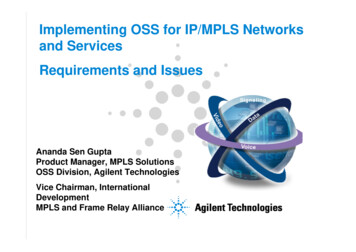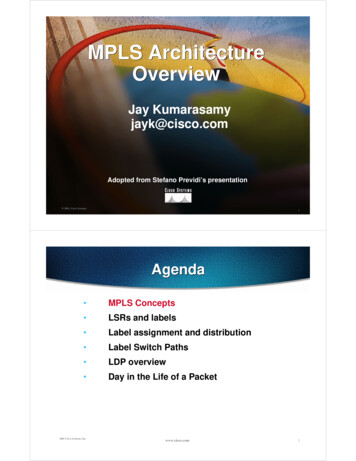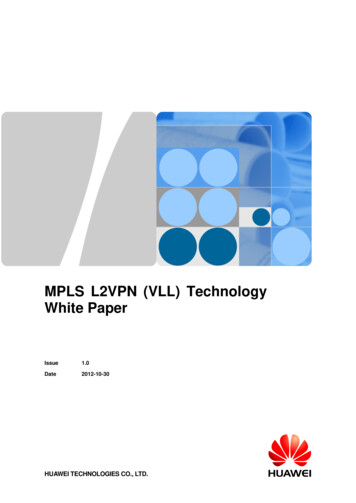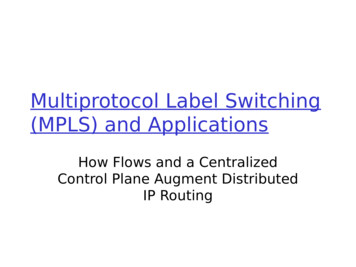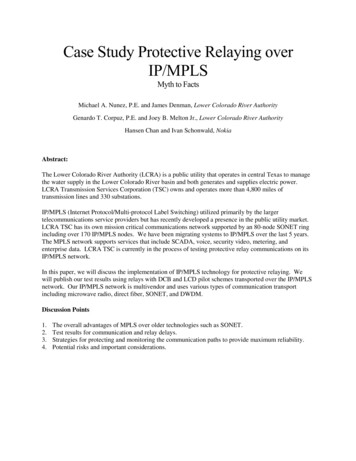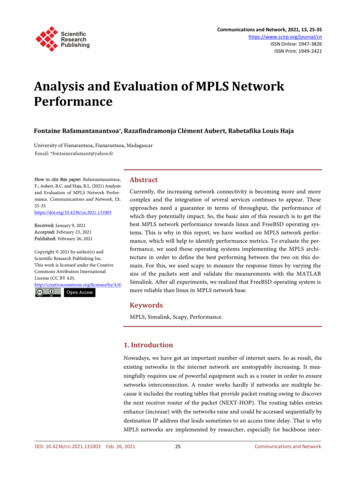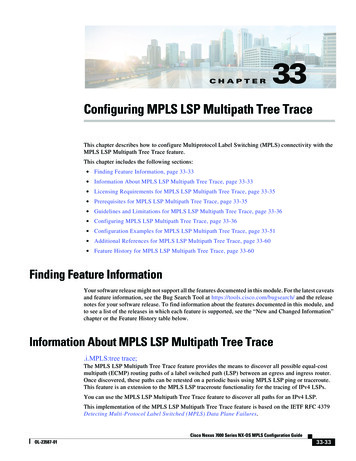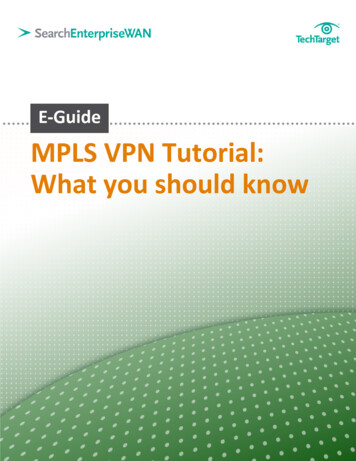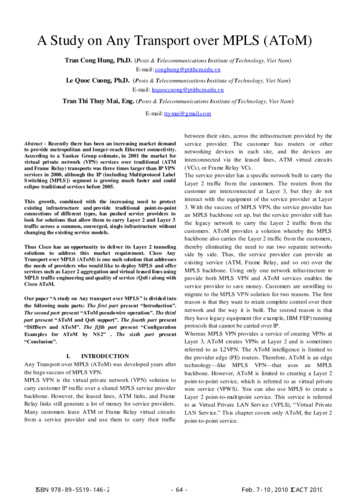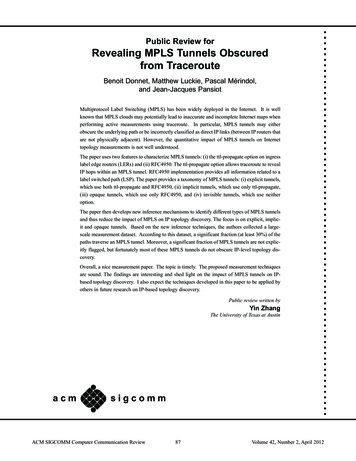
Transcription
Public Review forRevealing MPLS Tunnels Obscuredfrom TracerouteBenoit Donnet, Matthew Luckie, Pascal Mérindol,and Jean-Jacques PansiotMultiprotocol Label Switching (MPLS) has been widely deployed in the Internet. It is wellknown that MPLS clouds may potentially lead to inaccurate and incomplete Internet maps whenperforming active measurements using traceroute. In particular, MPLS tunnels may eitherobscure the underlying path or be incorrectly classified as direct IP links (between IP routers thatare not physically adjacent). However, the quantitative impact of MPLS tunnels on Internettopology measurements is not well understood.The paper uses two features to characterize MPLS tunnels: (i) the ttl-propagate option on ingresslabel edge routers (LERs) and (ii) RFC4950. The ttl-propagate option allows traceroute to revealIP hops within an MPLS tunnel. RFC4950 implementation provides all information related to alabel switched path (LSP). The paper provides a taxonomy of MPLS tunnels: (i) explicit tunnels,which use both ttl-propagate and RFC4950, (ii) implicit tunnels, which use only ttl-propagate,(iii) opaque tunnels, which use only RFC4950, and (iv) invisible tunnels, which use neitheroption.The paper then develops new inference mechanisms to identify different types of MPLS tunnelsand thus reduce the impact of MPLS on IP topology discovery. The focus is on explicit, implicit and opaque tunnels. Based on the new inference techniques, the authors collected a largescale measurement dataset. According to this dataset, a significant fraction (at least 30%) of thepaths traverse an MPLS tunnel. Moreover, a significant fraction of MPLS tunnels are not explicitly flagged, but fortunately most of these MPLS tunnels do not obscure IP-level topology discovery.Overall, a nice measurement paper. The topic is timely. The proposed measurement techniquesare sound. The findings are interesting and shed light on the impact of MPLS tunnels on IPbased topology discovery. I also expect the techniques developed in this paper to be applied byothers in future research on IP-based topology discovery.Public review written byYin ZhangThe University of Texas at AustinacmsigcommACM SIGCOMM Computer Communication Review87 Volume 42, Number 2, April 2012
Revealing MPLS Tunnels Obscured from TracerouteBenoit DonnetMatthew LuckiePascal Mérindol, Jean-Jacques PansiotUniversité de LiègeBelgiumCAIDA / UC San DiegoUSAUniversité de CTfound in an MPLS switching table. The MPLS forwardingengine is lighter than the IP forwarding engine because finding an exact match for a label is simpler than finding thelongest matching prefix for an IP address.MPLS routers may send ICMP time-exceeded messageswhen the LSE-TTL expires. In order to debug networkswhere MPLS is deployed, routers may also implement RFC4950 [7], an extension to ICMP that allows a router to embed an MPLS label stack in an ICMP time-exceeded message. The router simply quotes the MPLS label stack of theprobe in the ICMP time-exceeded message. RFC4950 isparticularly useful to operators as it allows them to verifythe correctness of their MPLS tunnels and traffic engineering policy. This extension mechanism has been implementedby router manufacturers since 1999 [8], and is displayed bymodified versions of traceroute [9] that report the label stackreturned by each hop in addition to RTT values currentlydisplayed. If the first MPLS router of an LSP (the IngressLabel Edge Router - LER) copies the IP-TTL value to theLSE-TTL field rather than setting the LSE-TTL to an arbitrary value such as 255, LSRs along the LSP will revealthemselves via ICMP messages even if they do not implement RFC4950. Operators configure this action using thettl-propagate option provided by the router manufacturer.These two “MPLS transparency” features – RFC 4950functionality and the ttl-propagate option – increase theobservability of otherwise opaque MPLS tunnels during IPlevel topology discovery based on traceroute. Unfortunately,lack of universal deployment of these two features (ingressLERs that do not enable the ttl-propagate option, andLSRs that do not support the RFC4950 ICMP extensions)means that current traceroute-based inference methods cancause false router-level links to be inferred and underestimates MPLS deployment in the Internet.In this paper, we develop and evaluate new inference methods to reduce the errors induced by MPLS tunnels on IPlevel topology discovery, by identifying their presence in theforwarding path even in the face of incomplete deployment ofthese two features. Section 2 presents a taxonomy of MPLStunnel configurations and how they appear in tracerouteoutput. Our taxonomy is conceptually a 2x2 matrix of thetwo MPLS transparency features. Section 3 positions ourwork amongst the current state of the art. In section 4 wedescribe our measurement experiment designed to quantifythe extent of MPLS tunnels obscured from traceroute. Ourexperimental results in section 5 indicate that MPLS tunnels are common in today’s Internet; from 75 vantage pointsto every routed BGP prefix at least 30% of traceroutes tra-Operators have deployed Multiprotocol Label Switching(MPLS) in the Internet for over a decade. However, its impact on Internet topology measurements is not well known,and it is possible for some MPLS configurations to lead tofalse router-level links in maps derived from traceroute data.In this paper, we introduce a measurement-based classification of MPLS tunnels, identifying tunnels where IP hops arerevealed but not explicitly tagged as label switching routers,as well as tunnels that obscure the underlying path. Using a large-scale dataset we collected, we show that pathsfrequently cross MPLS tunnels in today’s Internet: in ourdata, at least 30% of the paths we tested traverse an MPLStunnel. We also propose and evaluate several methods toreveal MPLS tunnels that are not explicitly flagged as such:we discover that their fraction is significant (up to half theexplicit tunnel quantity) but most of them do not obscureIP-level topology discovery.Categories and Subject DescriptorsC.2.1 [Network Architecture and Design]: NetworkTopologyGeneral TermsMeasurementKeywordstaxonomy, traceroute, MPLS, topology1.INTRODUCTIONMultiprotocol Label Switching (MPLS) [1] was designed toreduce the time required to make forwarding decisions. It isnow deployed to provide additional virtual private network(VPN) services [2] and traffic engineering capability [3, 4].To accomplish this, an IP router inserts one or more 32-bitlabel stack entries (LSE) into a packet, before the IP header,that determines the forwarding actions made by subsequentMPLS Label Switching Routers (LSRs) in the network. A series of LSRs connected together form a Label Switched Path(LSP). MPLS networks are deployed on IP routers that usea label distribution protocol [5, 6].In an MPLS network, packets are forwarded using an exact match lookup of a 20-bit label found in the LSE. AnMPLS LSE also has a time-to-live (LSE-TTL) field and atype-of-service field. At each MPLS hop, the label of the incoming packet is replaced by a corresponding outgoing labelACM SIGCOMM Computer Communication Review88Volume 42, Number 2, April 2012
MonitorR1R2IngressLERIHR1R2 - MPLSR3 - MPLSR4 - tion1.2.3.4.R1R4 - 5DestinationFigure 1: Taxonomy of MPLS tunnel configurations and corresponding traceroute behaviours. LSRs inimplicit tunnels do not explicitly reveal the use of MPLS. Opaque and invisible tunnels hide LSRs andcontribute to false router-level links.versed at least one explicit MPLS tunnel. Section 6 evaluates two complementary tunnel fingerprinting methods: onebased on the quoted IP TTL in ICMP time-exceeded messages, and the other on the IP TTL returned by suspectedLSRs in ICMP echo reply messages. Section 7 estimates thenumber of IP links missed and misinterpreted due to MPLStunnels that do not activate the ttl-propagate option. Finally, section 8 concludes the paper by summarising its mainachievements and discusses directions for future work.2.are hidden and the LH router does not flag itself aspart of an LSP. Again, a link between R1 and R4 iserroneously inferred.Only explicit tunnels are directly interpretable from traceroute output. The other categories require additional processing and/or active probing to interpret. In this paper, wepropose methods to identify implicit and opaque tunnels.3.MPLS TUNNEL TAXONOMYRELATED WORKSommers et al. recently examined the characteristics ofMPLS deployments that are explicitly identified using RFC4950 extensions, as observed in CAIDA’s topology data [11].In this data, they found explicit tunnels in 7% of ASes, andthe fraction was constant over three years of data; however, the total number of explicit MPLS tunnels varied overtime. They also developed a methodology to infer MPLStunnels in archived data where ICMP extensions are notrecorded. CAIDA’s topology data began recording ICMPextensions in May 2008; to enable MPLS deployment trendsto be analysed prior to this, they implemented a passiveBayesian inference method. Their key observations are (1)interfaces in LSPs are likely to be numbered using IP addresses that are close in terms of prefix length, and (2) RTTsof time-exceeded messages from all LSRs in an LSP arelikely to be similar because a common MPLS configurationexplicit tunnels: both ttl-propagate and RFC4950is for all LSRs to forward these messages to the end of theare enabled. The tunnel and its internal structure areLSP for the egress router to return1 . Our studies are comvisible. Each hop within the LSP is flagged as such (asplementary; we examine the deployment of explicit tunnels,illustrated with “MPLS” in figure 1).but we also develop methods to infer other configurationsimplicit tunnels: the ingress LER enables the ttl-propagatethat cause the LSP to be obscured from traceroute. In addition, because our studies are complementary our methodsoption but LSRs do not implement RFC4950. In thiscan be used conjointly to cross-validate each other.case, while the internal IP structure of the tunnel is visSherwood et al. investigated the presence of anonymousible, its existence as an MPLS tunnel is not revealed.and hidden routers as part of DisCarte [12]. They found thatAs illustrated in figure 1, the traceroute output of a0.3% of routers in their dataset were hidden from traceroutepath containing an implicit tunnel is equivalent to abecause they did not decrement the TTL. They identifiedtrace without any MPLS indication.anonymous and hidden routers using the IP Record Routeopaque tunnels: LSRs implement RFC4950 but theoption; however, they note that routers involved in an MPLSingress LER does not enable the ttl-propagate opLSP do not record an IP address in the IP option spacetion. Only the LH of the LSP reveals a LSE and theprovided, so the record route option is not able to identifyinternal structure of the LSP is hidden. In figure 1, thehidden routers in opaque or invisible configurations.opaque tunnel hides two LSRs (R2 and R3 ), allowing1an erroneous link to be inferred between R1 and R4 .That is, all traceroute probes through an LSP make thesame round trip. However, pure IP routers may be inferredinvisible tunnels: the ingress LER does not enableto be part of an LSP if (for example) an ASes preferredthe ttl-propagate option and RFC4950 is not imroute to the source of the traceroute probes is also throughthe same egress point towards the destination.plemented by the LH router. In figure 1, two IP hopsThe absence or presence of the two MPLS transparencyfeatures frame our taxonomy of four classes of MPLS tunnels. Figure 1 illustrates the four classes. In all cases, routerR1 is the entry of the MPLS tunnel and is the first routerto push an MPLS label; we call this router the ingress LER.Router R2 is the first LSR where the incoming packet includes a LSE; we call this router the ingress hop (IH). TheIH is the first LSR where RFC4950 applies and the first explicitly labeled hop. In figure 1 router R4 is the last routerthat pops the MPLS label; we call this router the last hop(LH). At least for Cisco routers, the LH router is locatedone hop before the egress LER due to the use of penultimatehop popping (PHP) [1, 10]. In this case, the last MPLS hopis implicit because the packet does not need to carry anyLSE. Therefore, our four tunnel categories are: ACM SIGCOMM Computer Communication Review89Volume 42, Number 2, April 2012
eapolis (US)London (UK)Auckland 15202530distance (IP hops)35totalMinneapolis (US)London (UK)Auckland (NZ)0.2400.00246810length (hops)(a) Fraction of paths with explicit (b) Distance of each unique explicit (c) Length of each unique explicitMPLS tunnels observed per monitorMPLS tunnel from each monitorMPLS tunnelFigure 2: Characteristics of explicit tunnels. Half of the monitors in our study observe an explicit tunnel inat least 40% of paths. In our data, 95% of unique tunnels begin at least 5 IP hops away from the monitor,and 90% of tunnels are less than five hops in length.4.DATASETfor identifying tunnels as there may be a different label foreach routed prefix. Counting MPLS tunnels this way yieldsan average of 1,200 explicit tunnels per vantage point, and aglobal total (i.e., the inter-monitor union of explicit tunnels)of 51,881 distinct explicit tunnels.We also quantified MPLS deployment at an IP interfacegranularity by counting the number of interfaces that returnan ICMP response with an RFC4950 MPLS extension, anddividing by the total number of interfaces observed. Our21,921 5.6% highlightingexperiment resulted in a ratio of 385,129that MPLS is well deployed in today’s Internet.Our results also indicate that MPLS is more prevalent inthe core of the Internet (i.e., in Tier-1 ASes) than in leaf networks (i.e., Stub ASes). Figure 2(b) plots the distributionof IP hop distance between the PlanetLab monitors and theIH router of an explicit LSP. In more than 95% of the cases,an MPLS tunnel starts at least five IP hops from the monitor location. Apart from extreme cases such as the sevenmonitors with MPLS support within the monitor’s hostingISP, the first tunnel is not located within the monitor’s ISPbut at least one AS further in the AS topology. Our diversity of probed destinations offers a comprehensive set ofindependent traces to study MPLS deployment.Finally, figure 2(c) plots the distribution of explicit tunnellength, i.e. the number of subsequent explicitly labelled IPaddresses2 . 90% tunnels are relatively short with no morethan five hops. However, we encounter a 23-router tunnelin the NTELOS network. It may be an anomaly, or it maybe a management LSP that purposefully crosses many nodesand links, allowing the member routers to be monitored withping, as a single probe will cross them all.Because only explicit tunnels are directly retrievable fromtraceroute output, we designed our own measurement experiment to study implicit and opaque tunnels. We usedParis traceroute with ICMP-echo packets [13] to collect theforward IP path, and for each interface discovered we sentICMP-echo probes in order to infer implicit tunnels (seesection 6.1). We generated target IP address lists based onprefixes found in a Route Views [14] BGP table from August 2011, probing a random address in each /16 for prefixesnot enclosed in any other prefix of length 16 or shorter, andprobing a random address in each other prefix of length 24 orshorter, but only one destination in any /24. We evenly divided each target list among a team of 25 PlanetLab vantagepoints (VPs). In total we used three teams (75 PlanetLabVPs) with three different target lists. Of the 75 VPs, 45were located within the US; the other 30 VPs were locatedin 18 different countries. Data was collected on August 24th ,2011 using scamper [15].5.EXPLICIT TUNNELSIn this section, we focus on explicit tunnels, i.e., LSPswhere the ttl-propagate option is enabled at the ingressLER and whose LSRs implement RFC4950. Our goal is notto show AS-level graph statistics or other statistics providedin [11] but rather to use explicit tunnels as a basis to estimate MPLS tunnels obscured from traceroute.Figure 2(a) provides, for each monitor, the fraction oftraceroutes encountering at least one explicit MPLS tunnel;monitors are sorted according to their proportion of traceroutes including explicit tunnels. For seven monitors (onein France, the others in North and South America), everytraceroute path traversed an MPLS tunnel since the hostingISP used MPLS. Apart from these extreme cases, MPLS isquite prevalent in our observations. Typically, more than30% of the paths we infer from each monitor exhibit at leastone explicit MPLS tunnel. This corroborates Sommers etal. recent results [11], where they observed an MPLS tunnelin 25% of their studied paths.Figures 2(b) and 2(c) plot characteristics of uniquely observed tunnels. We uniquely identify an MPLS tunnel asa list of labelled IP addresses h0 , h1 , h2 , . . . , hn 1 , hn ,where h0 is the IH router, hn the LH router, and hi ’s areLSRs within the LSP; we do not consider the MPLS labelACM SIGCOMM Computer Communication Review6.IMPLICIT TUNNELSImplicit tunnels are those that enable the ttl-propagateoption but do not enable RFC4950. They provide a classicbehavior when tracerouting through them; we do not missany information at the IP level and do not derive false linksbecause of their presence. However, LSRs within an implicittunnel are not flagged as such and require additional probingto reveal their existence and estimate MPLS deployment.2Note that the RFC4950 implementation is on a per routerbasis, therefore an explicit tunnel may be only a subset ofthe actual underlying MPLS tunnel.90Volume 42, Number 2, April 2012
propagateIP MPLSpropagateMPLS IPLSPq-ttl 1pushpushq-ttl 2pushpopIH LSRIngressLERq-ttl 3pushpoppop u-turn: 8 u-turn: 6popLH LSR u-turn: 4ping return pathq-ttl 4EgressLER u-turn: 2traceroute return pathFigure 3: Detection of implicit MPLS tunnels using TTL signatures. It is the LSE-TTL that is decrementeduntil expiry, so the quoted IP-TTL in ICMP time-exceeded messages will be 1; we infer an implicit tunnelusing signatures of increasing quoted IP-TTL values. Some LSRs send ICMP error messages via a nominatedrouter but send ICMP echo replies directly, so the IP-TTL of these packets will be different for the samerouter; we infer an implicit tunnel using signatures of decreasing difference in received IP-TTLs.explicitimplicitsignature coverageWe use the ping measurements in our dataset to detectu-turn signatures. As we observed each unique IP address,we sent it six ICMP-echo packets from the same monitor.Six ICMP-echo responses allows us to infer with 95% confidence [16] if there is a single return path length and thereforereduce measurement error caused by a reverse path containing load-balanced segments of different lengths. For morethan 99% of the interfaces tested, the reply TTL was thesame for all six responses. The u-turn signatures we searchfor are in the form of X, X 2, X 4, X 6, ., 2, 0where X corresponds to two times the tunnel length; X istwo times the tunnel length because in the ideal case thepath from the egress LER towards the monitor is via theingress LER, so each link in the LSP is crossed twice.Other behaviors occur and can also defeat the u-turn signature. For example, an LSR may be able to send thetime-exceeded reply by its own if it has an IP route tothe source. Similarly, if each LSR forwards the ping repliesthrough the egress LER there is no visible u-turn signaturebecause the return paths for time-exceeded and echo repliesare the same. In a more general case, each LSR may forwardecho replies through different exit routers back to the monitor, and the u-turn signature becomes more or less visibleaccording to the length of the LSP. Finally, operators canprevent our echo requests from reaching their router interfaces, and some LSRs may not be able to send echo repliesif they do not have a route towards our monitor, such as ifthey are not involved in the global IP routing plan itorFigure 4: The fraction of explicit and implicit tunnels as viewed by each monitor. Some monitors infer many more implicit tunnels, suggesting the location of each monitor can introduce measurementerror. We deduce implicit tunnels are three timesless prevalent than explicit tunnels.6.1Inference MethodologyIt is possible to detect some implicit tunnels by examiningthe IP packet quoted in an ICMP time-exceeded reply, inparticular the TTL of the probe quoted when the reply wasgenerated. This specific TTL is called the quoted TTL. Aquoted TTL 1 is likely due to use of the ttl-propagateoption at the ingress LER of an LSP. For each tracerouteprobe that visits a subsequent LSR within an LSP, the quotedTTL will be one greater, and we will observe an increasingsequence of quoted TTL values in traceroute. We call thisfingerprint technique the q-ttl signature, and it is illustratedin figure 3. We are not able to exploit the q-ttl signatureif a LSR sets the IP-TTL to the LSE-TTL (1) when theLSE-TTL expires.However, additional ping probing can reveal what we callthe MPLS u-turn tunnel signature. It relies on the fact thatmost LSRs in an LSP present a common behavior: when theLSE-TTL expires, the LSR first sends the time-exceededreply to the LH router which then forwards the reply to theprobing source, but the LSR sends other packets using anIP route if available. Operators can configure this behaviourusing the mpls ip ttl-expiration pop command on Ciscorouters. If the command is used, the IP-TTL received ateach monitor from packets sent by the same router will bedifferent for time-exceeded replies than for other packets,and for each LSR in an LSP we will observe a signatureof decreasing difference in IP-TTL values. In figure 3, theu-turn tunnel signature corresponds to the dotted lines.ACM SIGCOMM Computer Communication Review6.2EvaluationNext we evaluate our two fingerprint mechanisms by analyzing their presence in explicit tunnels. We expect a largefraction of explicit tunnels to cross-validate at least one ofour two tunnel signatures because the difference between explicit and implicit tunnels is implicit tunnels do not returntime-exceeded replies with RFC4950 extensions. If a largefraction of explicit tunnels also display q-ttl and u-turn signatures and these signatures are not more frequent in theglobal dataset, we deduce that our mechanisms are able todiscover most implicit tunnels.We first consider the echo-reply TTL minimizing the uturn value computed at each hop. If we consider the numberof IP addresses that are identified as LSRs either explicitlyusing RFC4950 extensions, or inferred using q-ttl and u-turn91Volume 42, Number 2, April 2012
1.0monitor location. We believe routing policies towards ourmonitors can lead to an overestimation of the number of implicit tunnels. Excluding the monitors where a large fractionof tunnels inferred are implicit, which we argue are outlierscaused by measurement error, suggests implicit tunnels arethree times less prevalent than explicit tunnels.Figure 5 plots the length of each type of MPLS tunnelinferred. In our data, implicit tunnels are shorter than explicit tunnels, mostly between two and three hops, as shownin figure 5. As MPLS forwarding policies may differ according to each monitor, using additional monitors allows us toreveal more u-turn signatures. However, it also can producefalse distinct implicit tunnels.Performing the same analysis considering the echo-replyTTL maximizing each u-turn delta, we notice that our signatures cover about 80% of explicit tunnels while 41% ofthem do not intersect any explicit tunnels (reported to theirquantity for tunnels longer than two hops). Maximizing u1 0.41 0.5).turn delta, we obtain a similar result ( 0.8Implicit tunnels seems to be between two and three timesless numerous than explicit 678910tunnel lengthFigure 5: Distribution of LSP length by tunnel type.We find that the distribution of tunnel lengths issimilar for explicit and opaque tunnels. There is ahigher fraction of short implicit tunnels, which webelieve is caused by limitations in our methodology.signatures, then we infer that more than 11% of IP addressesbelong to LSRs, and half of these are identified only throughsignatures. More than half of explicitly labelled IP addresses( 66%) also exhibit either q-ttl (48%) or u-turn (41%)signatures. The fraction of explicitly labelled IP addressescovered by u-turn signatures is lower because 30% of IPaddresses probed did not respond to ping. However, moreIP addresses with u-turn signatures did not intersect withexplicitly identified LSRs than did IP addresses with q-ttlsignatures.These results can be explained as follows: (1) the IP levelview is biased due to false signatures derived from smallisolated u-turn delta [2, 3], and (2) there exists some dependence between LSRs that include ICMP extensions andexhibit the q-ttl signature. To overcome the first limitationand accurately quantify the fraction of tunnels that are implicit, we decide to focus on tunnels whose lengths are atleast 3. For explicit tunnels that are longer than 3 hops,u-turn and q-ttl signatures are found in more than 75% ofexplicit tunnels; this value is almost constant for all tunnels between 3 and 10 hops in length. We therefore inferthat short u-turn signatures induce an overestimation of thefraction of MPLS tunnels that are implicit. Finally, we findthat 36% of tunnels at least three hops in length that wereinferred with q-ttl and u-turn signatures (implicit tunnels)do not intersect with explicit tunnels.6.37.7.1Inference MethodologyThe LSE-TTL returned by the LH in the time-exceededreply indicates the presence of an opaque tunnel and itslength, i.e., the number of hidden LSRs. When the ttl-propagate option is not activated, the ingress LER initialisesthe LSE-TTL to 255 so that the packet is unlikely to expirein the tunnel. Each LSR decrements the TTL, so when theLH router receives the packet the LSE-TTL will be 255 (n 1) for a tunnel of n hops. Note that an opaque tunnelof one hop is equivalent to an explicit tunnel of one hop andwe cannot distinguish them.In figure 1 the Ingress LER R1 sets the MPLS TTL to255, rendering the tunnel opaque; at the LH (router R4 ) theLSE-TTL will be 253, indicating that the tunnel obscurestwo LSRs. Based on this basic computation, we can estimatethe length of an opaque tunnel even if we are not able toreveal its internal LSRs.It is possible that the LH LSR may not include RFC4950extensions if it first pops the last MPLS label from thepacket before it constructs the ICMP time-exceeded reply. If this happens, the LSP falls into the invisible category. Using our own MPLS testbed, we notice that Cisco LHLSRs return an MPLS header in their ICMP time-exceededreplies when the ttl-propagate option is disabled at theIngress LER. Thus, we can reasonably conclude that in mostcases, the LH routers of opaque tunnels are visible.QuantificationAssuming our signatures are able to cover the same fraction of implicit tunnels as explicit tunnels, we deduce thereare approximatively half as many implicit tunnels as thereare explicit tunnels (0.36 34 0.5). This evaluation mayoverestimate the fraction of tunnels that are implicit: if asingle hop does not exhibit a signature then we may infer asequence of short implicit tunnels rather than a single longerimplicit tunnel. Therefore, our estimation of the fractionof MPLS tunnels that are implicit is likely to be an upperbound.Figure 4 plots the relative fractions of unique explicit andimplicit tunnels inferred in paths traced by each monitor.We split explicit tunnels into two parts; tunnels where therewas q-ttl or u-turn signature overlap, and tunnels wherethere was none. For most monitors, roughly 60% of explicitsignatures are covered by our signatures. However, the number of tunnels inferred as implicit is much more variable,and we do not believe the fraction of implicit MPLS tunnelscompared to explicit MPLS tunnels depends this much onACM SIGCOMM Computer Communication ReviewOPAQUE TUNNELSOpaque tunnels refer to tunnels whose Ingress LER doesnot enable the ttl-propagate option but where the LH enables RFC4950. Only the LH is visible and the opaque tunnel appears as a single-hop LSP, the remainder of the tunnelbeing hidden from traceroute (see figure 1). We declare each(Ingress-LER, LH) pair to be a unique opaque tunnel.7.2QuantificationIn our measurement experiment, opaque tunnels were notprevalent. We find that opaque tunnels are approximatelytwenty times less prevalent than explicit tunnels. This islikely to be a lower bound since we only count the LH ofopaque tunnels; unique paths between the ingress LER and92Volume 42, Number 2, April 2012
9.the LH are hidden. Regardless, the most significant contribution is the methodology to detect opaque tunnels andavoid the inference of false router-level links.Half of the opaque tunnels that we observed in our dataare short, between two and three routers, as shown in figure 5. We encountered two opaque tunnels made of 20 LSRs.It is possible to estimate the number of hidden and falselinks inferred when using traceroute to discover the IP-levelInternet topology. Figure 1 shows how missing two routerscan lead to a false inference of a link between R1 and R4 .The distribution of opaque tunnel length gives a hint of therout
Operators have deployed Multiprotocol Label Switching (MPLS) in the Internet for over a decade. However, its im-pact on Internet topology measurements is not well known, and it is possible for some MPLS configurations to lead to false router-level links in maps derived from traceroute data. In this paper, we introduce a measurement-based .
